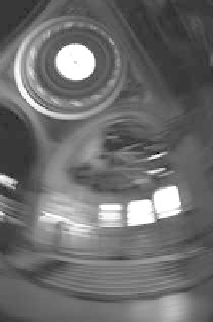Graphics Reference
In-Depth Information
(a) (b) (c)
Figure 6.5
Motion-blur resulting from spinning the camera. (a) An real photograph; the photographer
rotated the camera during the exposure. (b) Simulated motion blur using a conventional
photograph. Note the bright windows are not properly spread along the direction of motion.
(c) Simulated motion blur using an HDR image. The simulated motion does not quite
match the real motion of the camera. (From [Debevec and Malik 97] c
1997 ACM, Inc.
Included here by permission.)
an integer value of 0-255. This format is not sufficient to store an HDR image;
it simply does not provide the necessary range. A specialized
HDR file format
is
needed to store HDR images. The simple solution, using more bits per channel for
the HDR format , has the problem of requiring too much space: two or three three
times as many bits per pixel would be needed to store an image with a moderately
high range of pixel values. This is not a very efficient representation, because
each value does not have that much precision—the extra space is only needed to
store the general magnitude of the value, so each channel would have a lot of
zero or otherwise useless bits. A better approach would be to use a floating-point
format for each channel, but that requires even more space (normally 32 bits per
channel) and again there is the issue of unnecessarily high precision.
6.2.1 The Origin of the HDR File Format
Debevec did not have to look very far to find a file format capable of storing his
HDR images. Ward already had developed a file format for HDR images through
his work with the RADIANCE rendering system. Photorealistic rendering at-
tempts to model real world illumination, and because real world illumination has
a high dynamic range, so do the rendered images. The problem of tone map-
ping and storage of high dynamic range images was well studied in this context.










